

Making Star Trek IV: The Voyage Home

Released in 1986, coinciding with the franchise’s twentieth anniversary, The Voyage Home remains the most successful of the Star Trek feature films.
It is also the most lighthearted of the series, despite its lofty themes. Director Leonard Nimoy was responsible for both attributes.
Back in time
Early in the planning stage with Producer Harve Bennett, Nimoy had decided, “no dying, no fist fighting, no shooting, no photon torpedoes, no phaser blasts, no stereotypical ‘bad guy’.”
I wanted people to really have a great time watching this film, to really sit back, lose themselves and enjoy it. That was the main goal. And if somewhere in the mix we lobbed a couple of bigger ideas at them, well, then that would be even better.
Nimoy told Cinefantastique in 1987 that the first idea was to return the Enterprise crew to the Stone Age. The next idea was traveling back in time to 1890s. But the team quickly decided that the then-present day (1986) provided the greatest opportunities for fun, as the twenty-third-century characters would collide with contemporary life on Earth.
The next question was why the crew should travel back in time in the first place?
“There were several possibilities,” Nimoy said.
One, it could be an accident because they’re driving a ship they don’t know well. We decided not to do that. Then we thought, maybe they’re chasing somebody. We had done that before in Star Trek . Then we thought, what if there’s a problem in the twenty-third century and the solution lies in the twentieth century?
An epidemic? “We didn’t want to make a movie about people dying of diseases all over the place.”
The answer came when Nimoy was talking with a friend about endangered species “and up came the subject of the humpback whales and the mysterious song they sing.”
We don’t know exactly what it is or what it means. I thought, that’s it! If we can pull that off, sending humpback whales 300 years through space, that would be exciting.
Nimoy gave the story to screenwriters Steve Meerson and Peter Krikes. They drafted a 140-page script, which went through two rewrites. But the result still wasn’t very convincing.
Nicholas Meyer — who had cobbled together the best parts of the various scripts for Star Trek II — was called in to once again put the story together.

Meyer to the rescue
In an interview with the official Star Trek website in 2014, Meyer recalled that Paramount told him not to read the scripts but talk to Bennett and Nimoy.
They told me the story. Harve said, “Can you write the parts on Earth and I’ll do the bookends? I’ll do the beginning and the end.” I said, “Okay. Do they have to go to San Francisco in a time travel movie, because I’ve already done that? Can’t we go to Paris?” They said, “No, we can’t go to Paris.” So, I wrote all the stuff on Earth, beginning from when someone says, “When are we?” And Spock says, “Judging by the pollution content of the atmosphere, we’ve reached the late twentieth century.” And from there until they go back into outer space, was all my stuff.
William Shatner was involved toward the end. Meyer told Cinefantastique in 1987 that Shatner came back “with a whole bunch of notes,” which they incorporated.
He credited Bennett with keeping the process on track through numerous rewrites:
At times, when I would have long before thrown my hands up and told somebody to start suing, Harve would always go the extra mile, one more meeting, one more conversation, patiently holding everybody’s hand, and in the meantime also writing.
Acting and directing

Meyer had no desire to direct. “I was directing another movie.” Nimoy, who had successfully directed Star Trek III , was the obvious choice.
Nimoy told Cinefantastique he was lucky to be surrounded by people whose tastes he could trust:
I established very good contact with my cinematographer, so that he was watching carefully and he knew what I wanted to see. I’m very meticulous about the camera. I look through the camera on every shot and help line up the shot. I like my own compositions. If the cameraman shows me a composition I like, I say, “Great, that’s it.” Once I knew I could trust him, I knew I was technically covered.
The real challenge was balancing acting and directing.
You’re in the scene playing with one or two other performers and you’re giving your own performance, but you’re making mental notes like, “On the next take, I want to tell her to do something different here.” That gets complicated. But we managed to get through it.
Sharing the spotlight
The setting made it possible to give the supporting cast — James Doohan, Walter Koenig, Nichelle Nichols, George Takei — bigger parts.
Nimoy told Starlog in 1987 ( My Star Trek Scrapbook has the full interview ) that it is difficult to keep everybody happy all the time. “They know that, and I know that.”
We have tried from picture to picture to see that there was a balance from one film to the next. A person who perhaps had a little bit less to do in one would hopefully have a little bit more next time.

Filming in San Francisco
The twentieth-century also freed the production to shoot on location without the need to create an expensive illusion of the future in every frame. With half the movie set in the present, The Voyage Home contained the least amount of science-fiction design of any of the Star Trek films. Which, ironically, accounted for its wide general appeal.
Nimoy had fond memories of shooting on location in San Francisco. “I loved being there. I loved the whole idea of bringing Star Trek home to today.”

Visual effects
Bennett and Nimoy wisely retained the winning visual-effects team that had contributed to the success of the previous two movies. Industrial Light and Magic was excited about the opportunity.
“ Star Trek has been in space so long,” Ken Ralston, the film’s consulting effects supervisor, told Cinefantastique .
You’ve seen it all before, many times. But to see those ships that you’ve become accustomed to put into a more terrestial environment is refreshing. When I have a ship in front of a starfield, I have no opportunity to be creative. Sure, I could put another nebula out there, but we’re really locked into things. When we come down to a more interesting environment, boy, the possibilities are endless.
One of the most memorable images of the film was the Klingon Bird of Prey swooping under the Golden Gate Bridge. Ralston also remembered it as one of the most difficult shots to get right.
ILM built an almost 5 meter-long model of a section of the bridge. Because it had a forced perspective, the foreground roadway measured about 16 inches [40 centimeters] wide while at the very end, on the other side of the tower, it was 2 inches [5 centimeters] wide.

Originally, ILM model shop supervisor Jeff Mann had hoped that by photographing storms in San Francisco, they would be able to save themselves the trouble of creating one artificially. No such luck.
Even though it was storming, on film it looked pretty tame. We wanted the storm in the film to be wild.
So they built a tank, “and then we tried everything to create rain and wind and smoke levels and clouds, using wind machines and water sprayers.”
Mann remembered the end result as “quite a thing to see”.
We had the Golden Gate Bridge sitting in the water tank, wind machines, foggers and sprayers, and the wire rig with the Bird of Prey flying past as it crashed into the water. That was fun.
Another effect was so realistic that few viewers noticed it wasn’t real: the humpback whales themselves were either miniatures shot at ILM or life-sized robotic replicas filmed in the Paramount parking lot.
The studio had hoped to use stock footage of humpback whales, but there wasn’t much available and the movie needed them to behave in certain ways. That also meant miniatures weren’t always sufficient.
To make sure both the miniatures and the life-sized mechanical whales looked accurate, they were built under the watchful eye of Peter Falken of the Oceanic Society.

Critical response
For the first time, the critical response to a Star Trek film mirrored its fortunes at the box office.
Understanding its appeal, USA Today wrote that the film would “delight those who don’t know a tribble from a Romulan” and that the funny script “turns Kirk and his followers into the most uproarious out-of-towners to hit the Bay area since the Democrats in 1984.” Referring to the film’s reduced use of visual effects, the review went on to note that without the usual special-effects camouflage, “the performers prove themselves more capable actors than ever before.”
Janet Maslin of The New York Times summed up the film’s impact best when she noted that The Voyage Home “has done a great deal to ensure the series’ longevity.” That there would be a fifth film was a near certainty.

- More to Explore
- Series & Movies
Published Jan 4, 2019
Star Trek IV: Did You Know That...
We're sharing some of our favorite fun facts about the making of the film
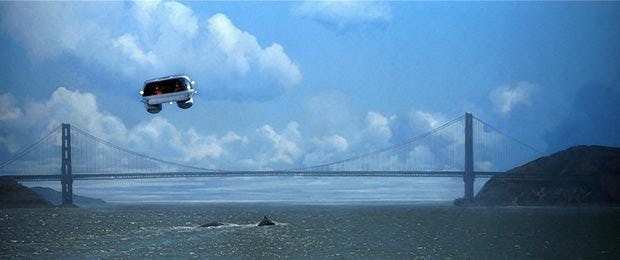
startrek.com
During April of 1986, I (John) was getting ready for final exams and couldn’t accompany my parents on a vacation they were taking to California. Little did I know my voluntary absence from that year’s family vacation meant I missed an opportunity to watch the filming of Star Trek IV: The Voyage Home . By luck, my parents—Vincent and Josephine—happened to visit the Monterey Bay Aquarium on April 29, 1986. With a 1980s behemoth video camera in tow, my parents forwent their planned tour, and stayed all day to film William Shatner, Leonard Nimoy and Catherine Hicks as they rehearsed and filmed the important exposition scene where the plight of whales is explained. In the era before the ubiquity of camera phones and social media, there were no restrictions on the audience filming the action. When my parents returned from their vacation, they surprised me with almost an hour's worth of footage of the filming of the next Trek adventure. I couldn’t understand why Kirk and Spock were walking around a modern-day aquarium, but that footage – watched again and again – gave me a lifelong appreciation for the hard work that the actors and behind-the-scenes crew undertake to shoot a Star Trek movie.
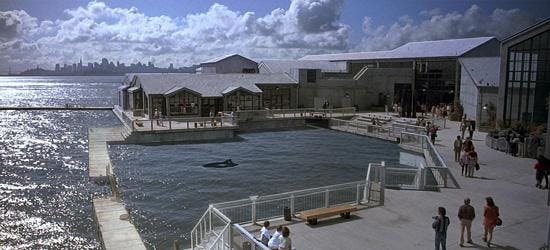
That footage also inspired a desire to learn all there was about the making of Star Trek IV: The Voyage Home . Here are some of the favorite fun facts about the making of the film that we have learned while researching the behind-the-scenes memos, scripts, and production information available at the University of Iowa Library’s “Papers of Nicholas Meyer Collection.” What’s in a Name?
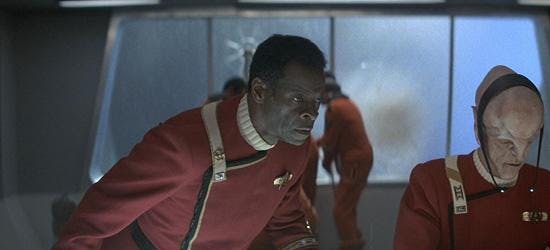
- Admiral Lance Cartwright (played by Brock Peters) was originally the character of Admiral Harry Morrow (played by Robert Hooks) in the first several versions of the script. Morrow was the Admiral who fans were familiar with from Star Trek III: The Search for Spock , who ordered the decommissioning of the U.S.S. Enterprise and forbade Admiral Kirk from going to the Genesis Planet.
- Gillian Taylor’s character was for a time named Shelley Clarke.
- George and Gracie were originally named the more Biblically inspired monikers of Adam and Evie.
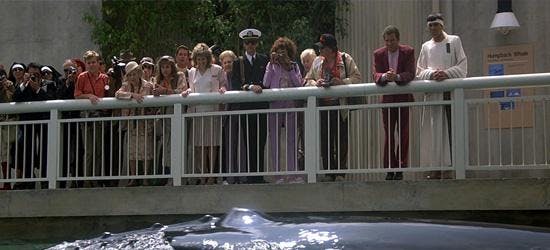
- The real name of the whale museum, the Monterey Bay Aquarium, could not be used because the script required the action to take place in Sausalito, closer to San Francisco.
- The October 18, 1985, Revised First Act draft of the script by Harve Bennett listed the name of the film as Star Trek IV: The Adventure Continues
Could Have Beens:
- In a scene that has not yet appeared as a bonus feature on home video, the October 18, 1985, version of the script has a scene where Commander Christine Chapel greets Ambassador Sarek as he arrived uninvited to the Federation Council’s meeting about the fate of Admiral Kirk and crew. A Federation Guard will not allow Sarek into the meeting because he does not have the proper entry medallion credentials. Chapel puts the guard in his place, telling him that “This man is Ambassador Sarek of Vulcan, as any school child would know.” The scene is interesting because it implies that Sarek may have been called to Earth by Chapel to testify and not at the request of the Council, and it is also appropriate that Chapel—whose love for Spock is documented in the original show—would stand up for Sarek in his attempt to help his son and Chapel’s former crew mates. The Official Star Trek Communicator Magazine (the publication of the Official Star Trek Fan Club by Dan Madsen) included a picture from the scene at the time.
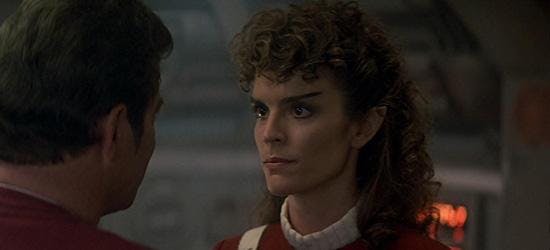
- Saavik was indeed pregnant with Spock’s child in the early versions of the script. During Spock and his mother Amanda’s conversation, the script has Amanda trying to tell her son the news, but she hesitates and does not. Kirk and Saavik discuss the situation, with Saavik eventually not telling Spock. Had this scene been included as written, it would have meant that Saavik and Spock’s situation very likely would have had to have been dealt with in a future film. As is, Star Trek IV: The Voyage Home was Saavik’s last on-screen appearance (although the character of Valeris was originally written as Saavik in drafts of the Star Trek VI: The Undiscovered Country script).
What date does the crew arrive in 1986 San Francisco? This is a difficult question to answer. One of the scripts (again the October 18, 1985, Revised First Act version) lists the date as December 19, 1985 for the crew’s arrival back in time. However, a careful look at the newspaper the crew reads upon first landing appears to reveal the date to be Thursday, December 18, 1986. If that is the date, then the audiences on opening night in the United States was doing a bit of time traveling themselves, watching events unfolding several weeks after the actual date of the premiere of the film! Complicating December 18th being the official date of the crew’s arrival in San Francisco is a prop that was on display at Star Trek: The Experience . The prop was the pawn store ticket given to Admiral Kirk when he sold his glasses for cash. The date on the ticket is August 19, 1986, four months before the newspaper date the crew looks at a few moments earlier (however, the ticket is not visible on screen directly). By the way, the name of the pawn store according to the prop ticket is Feinberg’s Loan & Pawn. It appears that Kirk gave the pawn store owner the alias name of Sydney Carton and the fake telephone number of... wait for it... 555-1701!
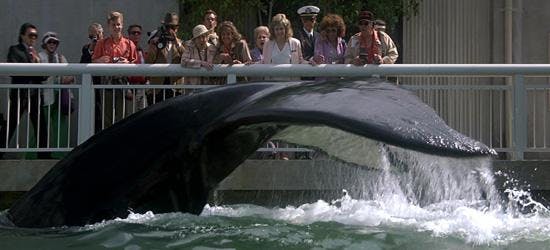
I never did get a chance to see the filming of a Star Trek film. But, by missing my chance in 1986, I learned two important lessons. First, I got to experience another great example of why my Dad and Mom were such great parents, sacrificing a good portion of their day to film something only because their son was a fan. Second, I learned that there are many talented people required to make a Star Trek film. When the credits roll, we continue to marvel at the contributions of the men, women, and whales, that helped make The Voyage Home so incredibly special.Special thanks to: The University of Iowa Libraries, Memory Alpha, Nicholas Meyer, Dan Madsen, and Vincent and Josephine Tenuto. Maria Jose and John Tenuto are both sociology professors at the College of Lake County in Grayslake, Illinois, specializing in popular culture and subculture studies. The Tenutos have conducted extensive research on the history of Star Trek , and have presented at venues such as Creation Conventions and the St. Louis Science Center. They have written for the official Star Trek Magazine and their extensive collection of Star Trek items has been featured in SFX Magazine . Their theory about the “20-Year Nostalgia Cycle” and research on Star Trek fans has been featured on WGN News, BBC Radio, and in the documentary The Force Among Us . They recently researched all known paperwork from the making of the classic episode "Space Seed" and are excited to be sharing some previously unreported information about Khan's first adventure with fellow fans. Contact the Tenutos at [email protected] or [email protected].
Get Updates By Email
- Search Please fill out this field.
- Newsletters
- Sweepstakes
Star Trek IV: The Voyage Home is pure, joyful cinema
Entertainment Geekly's 'Star Trek' series looks at the best whale movie ever made
:max_bytes(150000):strip_icc():format(webp)/darren-franich-image-d84c07f43f304fcdad508d73032168e8.png)
2016 marks the 50th anniversary of the Star Trek franchise – and the release of Star Trek Beyond , the 13th feature film in the series. To celebrate this big year, and ponder the deeper meanings of Trek ’s first half-century, the Entertainment Geekly column will look at a different Star Trek film each week from now till Beyond . This week: The only Trek film that feels like a Howard Hawks comedy. Last week: The Trek film about the clashing egos of William Shatner and Leonard Nimoy . Next week: Shatner unleashed .
In 1965, Leonard Nimoy said the first words ever uttered in the Star Trek universe. “Check the circuit!” says Spock at the start of “The Cage,” the original pilot for Star Trek and the first time Star Trek was boring. To modern eyes, Spock doesn’t look like Spock: Eyebrows too big, hair too mussed, a noose-collar atop a too-baggy uniform, flanking an un-Kirk Captain who looks too much like Jay Leno’s chin chest-bursting out of Ray Liotta’s face.
NBC didn’t like Star Trek , didn’t like Spock. A year later, Gene Roddenberry filmed a new pilot. He fired everybody — he fired his mistress! — but he kept Nimoy.
Twenty years later, Roddenberry was gone — to Next Generation , not for long — and Nimoy was in control. Tricky thing, applying words like “control” or “authorship” to anything Star Trek . Nimoy directed Star Trek IV: The Voyage Home , and received a “Story By” credit. So did Harve Bennett, the producer of Movie Two through Movie Five, making him another Man Who Saved Star Trek and another Man Who Almost Destroyed Star Trek . Bennett shares screenplay credit alongside three other men. One of those writers later wrote Double Impact , the movie where Jean-Claude Van Damme headbutts Jean-Claude Van Damme.
And one of those writers was Nicholas Meyer, the man who made Wrath of Khan . Meyer’s generally credited with writing the film’s 20th Century-set Act 2. Perhaps not coincidentally, The Voyage Home has one of the greatest and daffiest Act 2’s of any film ever. Here is a movie that begins as A Race Against Time To Save The Earth and then takes a sharp detour into aquarium etiquette and Bay Area geography; a movie where the stakes are global, and there’s plenty of time for Kirk to take a marine biologist out for an Italian dinner; a movie where Kirk is a noble romantic protagonist who makes his date foot the bill. There’s a wonderful lack of seriousness powering The Voyage Home , recalling Howard Hawks’ loopy genre exercises To Have and Have Not or The Big Sleep . It is the kind of movie where characters spend the whole movie taking a break from the movie.
So it was a team effort, in front of the camera and behind the scenes. But it was a team effort with a leader. And the leader wanted to make a different kind of film. Nimoy later explained the core concept: “No dying, no fighting, no shooting, no photon torpedoes, no phaser blasts, no stereotypical bad guy.” His previous Star Trek film had all those things, and outer space, and aliens, and sets. Nimoy wanted to make a movie about Earth, right now, shot on location, with human people.
Nimoy was an actor, a director, a photographer, a memoirist, a musician, a cameo cartoon voice, a face in advertisements that baited your nostalgia and dared you not to smile. In all things he was Spock. Sometimes that bothered him: He wrote I Am Spock , but also I Am Not Spock . Nimoy was never a dilettante, a preening highbrow — never the Alan Rickman character from Galaxy Quest, that self-loathing Shakespearean slumming for fanboy dollars and residual fame. Nimoy liked Spock, truthfully. He liked the work, occasionally. He liked the money, naturally: $2.5 million for Trek IV . (That’s more than Hemsworth made on Avengers — and that’s mid-’80s dollars, unadjusted.) Nimoy was frustrated with Spock, but it wasn’t merely the frustration of typecasting or of repetition. It was the internal struggle, the human condition: Nimoy struggled with Spock the way Hamlet struggles with Hamlet.
And Nimoy loved people. That sounds like a simple thing to say, until you watch The Voyage Home , one of the loveliest and strangest and lightest comedies ever made, and you realize that “loving people” can be something tangible, like an added filter on the camera. Nimoy loved the supporting players, and his film bestows each of them with a Hall of Fame moment. Scotty: “A keyboard. How quaint .” Chekov: “Nuclear wessels .” Uhura: “But where is Alameda ?” McCoy, undercover as a surgeon, asks an old lady in a hospital what’s wrong with her. Kidney dialysis, she says. “Dialysis!” McCoy sputters — an actual honest-to-god sputter, DeForest Kelley’s voice like an old engine cackling. “What is this, the Dark Ages ?”
Sulu was supposed to get a showcase scene meeting his own great-great-great-grand-something. It didn’t work out — the kid got scared — and Nimoy was still bummed about it a decade later when he wrote I Am Spock . But oh, how I treasure Takei, in his baritone voice, narrating the Enterprise’s warpspeed run into the center of our solar system: “Nine point five! Nine point six! Nine point seven! NINE POINT EIGHT! ” (And The Voyage Home continues one of the great embedded subplots in Trek history: The love story between Sulu and the Excelsior .)
Did I mention that they’re warping straight into the sun so they can travel through time? There’s an energy-sapping probe destroying Earth, apparently because no one can respond to the probe’s message. Is the probe saying “hello” to humanity? “Only human arrogance would assume the message must be meant for man,” Spock chastises.
It’s been said there are no villains in Star Trek IV. In the future, the probe hails from some unknown intelligence that almost destroys Earth by accident. In the past, every hint of antagonism is quickly undercut. At one point, Chekov is captured by the FBI, and there’s a much simpler, more on-the-nose version of this movie where the FBI becomes the bad guys. Maybe that wouldn’t be terrible; maybe it would be sharp, playing the utopian sensibility of the Federation against Cold War paranoia. But in The Voyage Home , it’s an opportunity for a “Who’s On First” routine:
FBI AGENT: Let’s take it from the top.
CHEKOV: The top of what?
FBI AGENT: Name?
CHEKOV: My name?
FBI AGENT: No, my name.
CHEKOV: I do not know your name!
FBI AGENT: You play games with me, mister, and you’re through.
CHEKOV: I am? Can I go now?
At this point, the FBI agent — who looks like the uncanny valley between Paul Rudd and Armie Hammer — whispers to his partner, “What do you think?” His partner says, “He’s a Russkie.” The FBI agent, completely deadpan, missing a beat: “That is the stupidest thing I have ever heard in my life.” Every one-scene character in The Voyage Home is smarter than they should be, wittier than they have to be. Chekov grabs his phaser and tries to fire it, but it’s run low on batteries. He tosses it to the FBI agent, and watch closely here.
The actor is Jeff Lester — who naturally played both “Lane Brody” and “Lance Jarvis” on Baywatch — and he catches the phaser with a look of weary amusement. Here’s a film where the shady FBI guys feel tired, and a bit embarrassed, about being shady FBI guys.
The Voyage Home reminds me of something Dan Harmon told Vulture regarding Cheers : “The characters were so distinct. As with Peanuts , you could put them in outer space and still know which one was Charlie Brown.” The Voyage Home is the inverse of that theorem: It takes its characters from outer space and sets them down on the streets of San Francisco, in the halls of the Monterey Bay Aquarium, in the front seat of a truck. And here’s something strange. You’ve seen Kirk and Spock on alien planets production designed like pop art comic strips, in cosmic mountain ranges battling aliens beyond our ken; you’ve seen them battle gods and monsters.
Yet I don’t think there is any single moment in Star Trek history where Kirk and Spock look better — at once grander and more approachable, like statues of the Founding Fathers buying rounds at sports bar — than the moment when they walk along Marina Boulevard. Behind them: The bay, the Bridge, the fog.
Kirk’s still wearing his magenta-maroon disco suit, looking like the communist dictator of Studio 54; Spock’s wearing a karate bathrobe. You can giggle at the buried joke of the movie — they fit right into pre-digital San Francisco — but you can also appreciate how the movie makes them seem so much bigger by bringing them down to Earth.
No other Star Trek film has done location shooting like this; maybe The Voyage Home is Trek as neo-realism. Legend holds that the “nuclear wessels” scene was shot in secret, with Walter Koenig and Nichelle Nichols talking to random passers-by. That’s maybe not true — counter-legend holds that those are all paid extras — but in the most memorable part of the scene, Russian Chekov asks a nearby policeman for directions to the closest nuclear reactor. The cop says nothing, doesn’t even move; he was an actual San Francisco, working with the production crew in an official capacity. So, actually, hang the neo-realism: The Voyage Home is as close as Trek ever gets to the start of “Duck Amuck,” when Daffy walks off his own film strip.
The humor of The Voyage Home is playful without ever becoming sarcastic, self-aware without ever feeling like self-loathing. The characters feel engaged — watch how Takei is constantly looking around San Francisco, a great grin on his face. Think of how this movie shifts from Act One to Act Two: Spock says they need to save the whales; Kirk says “Let’s time travel!”; and then they aim their ship right into the sun. Think, too, of Catherine Hicks, in a tricky role. She plays Gillian, the whale-loving marine biologist. She thinks Kirk and Spock are crazy, but intriguing; she doesn’t really believe they’re from the future, but she intuitively understands that they’re people she should hang out with.
A lesser film might try to architect this interaction somehow. (Maybe Gillian is an FBI agent; maybe the wrong thing for America circa 1986 is the right thing for the world .) Hell, one of the greatest hours of television ever is a Star Trek time travel episode where Kirk goes to the past and falls in love with the most important woman in history. The Voyage Home has no time for such pretensions. Gillian’s an obvious love interest, but they never really have a “romantic” scene. Gillian thinks Kirk is interesting; Kirk likes how much she cares. And Gillian is allowed to come to the future — where she promptly says goodbye to Kirk, because there’s just so much more to see.
Their final scene together is one of the most graceful light-comedic romance moments in any movie I can think of. “How will I find you?” he asks her — kidding but not quite, Shatner’s laugh a bit too forced. “Don’t worry,” she says. “I’ll find you.” Nimoy holds his camera for two long moments, first of Gillian saying farewell:
Then of Kirk, astonished. What do you think is going through his mind?
Is he amazed that, for once, he’s the one left behind? Is he bemused at the grand divine comedy of existence? Maybe I’m a shameless romantic, but I can’t help but imagine his thought bubble in Shatnerian overspeak: “My god, Bones! I think I’m in love!”
Shatner! My god, Shatner! Another one of the graceful jokes powering The Voyage Home is that, here in the past, Captain Kirk remains the most confident man in the galaxy, despite all indications that he doesn’t know what the hell he’s doing. Needing money, he pawns McCoy’s birthday glasses at an antique shop. The owner will pay a hundred dollars for them. “Is that a lot?” Kirk asks, smiling wide like a con man.
Later, at the aquarium, Kirk spots Spock swimming with the whales, and his wild overreactions belong in a silent movie museum:
Of course, Kirk is a con man in The Voyage Home . To his crew, he pretends to know everything about the past. (“Double dumb ass on you!”) To people in the past, he offers one BS line after another. (“I think he had a little too much LDS.”) The joke of his brimming confidence paired against Spock’s Holy Fool confusion reaches Chico-and-Harpo levels:
But the film isn’t some shallow self-parody of Kirk, or Star Trek . It has heart, and passion — Save the Whales! — and a tremendous sense of fun. When the crew crash-lands into the Bay, they need to climb out of their sinking ship. The whales start singing; the probe is vanquished. Another film might cut away, but Nimoy’s camera lingers, and we watch the crew of the Enterprise cheerfully jump into the water. The line between character and actor falls away, phasered into nonexistence. James Doohan does a bellyflopping dive into the water; Nichelle Nichols splashes water toward DeForest Kelley. At one point, Kirk pulls Spock into the water — or maybe that’s Shatner and Nimoy, fooling around.
And yet, there is a seriousness to the wonderful, exuberant silliness of The Voyage Home . At the film’s beginning, the resurrected Spock is asked a question: “How do you feel?” At the end of the film, Spock has traveled across space and time, has rescued a dead great species from the dustbin of existence, has saved the Earth one more time. And none of that plot stuff matters half so much as Spock saying, nonchalant: “I feel fine.” To feel “fine” is not to feel “perfect” or even “happy,” does not imply tremendous success nor some massive personal change.
To feel “fine” in The Voyage Home is to be aware of your place in the great scheme of existence, content in your place among your fellow creatures. There is such optimism in this movie, and perhaps that optimism is residual from Roddenberry — but Roddenberry preferred grand statements, not whimsy. The Voyage Home needed Nimoy, a thoughtful man with a sense of humor, a leader who loved his people, and loved people in general, and damn it, who loved the whales, and Earth, and the Golden Gate Bridge, and the nightmare intersection where Columbus and Kearny and Jackson hit each other right in front of the Zoetrope Building.
Nimoy died last year, age 82: A long life, and prosperous. Spock will live forever, of course — and The Voyage Home is his magnum opus. Quickly, listen to the theme music for Voyage Home by Leonard Rosenman.
Can you hear the festive melody? Aren’t those bells ringing vaguely yuletidal? There’s no obvious comparison in movie history for Star Trek: the Voyage Home , not many time travel message movies about family and friends and the fear that we’re all doomed because of sins in the past, and how that fear will always crash like waves against the shore of the eternal human hope that it’s not too late, that we can change.
But there is that famous story about heavenly visitors and time travel, a myth about how any person can change a dark-sad future into a happy-better one, a parable that argues that the great heroic act of existence is being an engaged part of a community. So maybe The Voyage Home is our new A Christmas Carol . Maybe Ebenezer Scrooge can save Tiny Tim; maybe the Earth isn’t doomed; maybe, in 2286, whales will still be swimming through oceans unrisen; maybe our descendants will be here, too, in this world someone saved for them. Probe bless us, every one.
THE WHOLE MOVIE IN ONE SHOT:
Related Articles
Star Trek 4: Plot, Cast, Release Date, and Everything Else We Know

Your changes have been saved
Email Is sent
Please verify your email address.
You’ve reached your account maximum for followed topics.
Star Trek 4 is shrouded in mystery and apparent defeat. The sequel to Star Trek: Beyond on J.J. Abram’s Kelvin timeline is currently stuck in dry dock. There have been plans for Paramount to make the movie for years , and sometimes, it even seems like they’re going to do it. Fans were hopeful in 2022 when it looked like things were about to go ahead, but when the stars aligned, director Matt Shakman stepped down from the project to work on Marvel’s Fantastic Four reboot instead.
Trekkies everywhere were heartbroken. Although Paramount continues to produce good Star Trek series like Strange New Worlds and Discovery , it doesn’t look like we’re going to get that big blockbuster film any time soon. That being said, hope still exists. Star Trek 4 is one of Paramount’s biggest, untapped titles, and the stars are still up for another journey into the final frontier. Things are looking dark, but somewhere, out there in the vastness of Hollywood, there is a way to make this movie. Fans still whisper, and celebrities still talk, and time and time again, it appears as if Star Trek 4 is emerging from the water.
Updated January 22, 2024: This article has been updated by Jessica Peerez with more recent information regarding Star Trek 4, the development hurdles of the film and the plans that Paramount Pictures appears to have for the franchise.
Star Trek 4: The Plot
There were a lot of rumors about the plot coming up to Star Trek 4 ’s removal from Paramount’s release slate. When Paramount first announced the sequel, the intention was to have it bring back Chris Hemsworth, who, since his small role in the first film had blown up as a Hollywood superstar thanks to his role as Thor in the MCU, they wanted him to reprise his role from the 2009 film as George Kirk, James T. Kirk’s father. This version of the script made it far enough through development to actually reach the actors. The pitch was to do Indiana Jones and the Last Crusade but with Star Trek , where when the Enterprise investigates the wreckage of the Kelvin, they find that an exact copy of George Kirk was stored in the ship transporter so he is able to return to life at the exact moment before his death and much of the movie would have been how the two Kirks do not get along as neither of them is what the other expected before needing to accept one another for who they are. In an interview with Josh Horowitz , Hemsworth explained how he felt about the story:
"It wasn’t what I was thinking it would have been or could have been. And I thought, ‘Oh, cool, let’s figure that out and keep going’ and then I think everyone just got busy and so on. It’d be a bit weird now to flash back to your father and ‘Why is he so much older than when he died?’"
Not only did Hemsworth pass on the project, but negotiations broke down in terms of pay with both him and star Chris Pine. Paramount then decided to pivot, bringing on Noah Hawley ( Fargo, Legion ) to write a new Star Trek film with a new cast of characters. J.J. Abrams was even having conversations with Quentin Tarantino about giving him an opportunity to write a Star Trek movie . While Tarantino did begin work on a script, he eventually passed on the project as he plans to retire after ten movies and he did not want Star Trek to be his final movie. Meanwhile, Hawley's pitch was scrapped as the story involved a plague, and following the COVID-19 pandemic, Paramount was not keen on that idea. It was then decided to make a direct sequel to Star Trek Beyond and bring back the original cast.
In July 2021, Matt Shakman was hired to direct Star Trek 4 . Then, in February 2022, when Paramount Pictures made the big splashy announcement that the original cast of the three previous Star Trek movies would return after it appeared years of contract negotiations had held them up, they had nothing. Even the stars and their agents were surprised that they were going ahead with the movie when, apparently, they hadn’t told a soul. The plan was to secure investors first and sort the details out later, which they did, eventually. When writers started sitting down at their laptops, there was much talk about where a story could go.
Related: Star Trek: The Funniest Episodes in the Franchise, Ranked
The studio seemed confident in the film and dated it for December 23, 2023, to take the slot that was previously held by Star Wars: Rogue Squadron , which had recently been vacated due to creative differences between Lucasfilm and director Patty Jenkins. While it felt like they would have little time, many fans were hoping they could make the release date. But in August 2022, Shakman would drop out of Star Trek 4 in favor of directing Fantastic Four , and Paramount removed Star Trek 4 from their release schedule.
Despite the stumbles in its journey, repeated delays, and the dismay of hopeful fans, Star Trek 4 appears not to have been fully scrapped yet. In September 2023, screenwriter Lindsey Anderson Beer confirmed that Star Trek 4 is still moving forward. The fourth film will reportedly be the final chapter of the main series. With no new information to dispute the claim as of January 2024, it appears that the fourth installment might still make it to screens. However, with the lack of information regarding a concrete plot or cast and Beer having since left the project , Star Trek 4 might have a long road ahead before viewers can once again join the USS Enterprise on an adventure as now Paramount Pictures is shifting to a new prequel film.
Star Trek 4: The Cast
The original hope for the movie — no matter which way the plot went — was to get as much of the original cast back on board as possible. Although talks fell through with Chris Hemsworth and his part in the film, Chris Pine ended up making a solid deal to return as Captain James T. Kirk . Zachary Quinto had been confirmed as Spock, and John Cho would come back as Sulu. Simon Pegg, even though he helped write Star Trek: Beyond and played Scotty, made no commitments either way, but it would be likely that he would return due to his major involvement with the films.
Karl Urban, who plays Bones, said that he had some scheduling conflicts due to his work on The Boys , but now that the schedule has changed, his participation remains to be seen. Zoe Saldaña has commented on some frustration for working in so many franchise films, but she would return if the movie was able to pull itself together. Of course, due to the untimely death of Anton Yelchin , Chekov's character would not be recast but instead respectfully written out of the movie.
Star Trek: Everything Else
It has now been nearly eight years since the last Star Trek film, Star Trek Beyond, came to screens. Uncertainty has continuously clouded the fourth film, and despite its status as still being in active development, Paramount looks to be moving ahead with a brand-new film. According to Variety , the new film has Andor 's Toby Haynes in the director's seat, with Seth Grahame-Smith penning the script. J. J. Abrams's Bad Robot will be produced.
Details regarding the plot and cast of the new movie have not been confirmed yet. However, it is set to be an origin story that takes place decades before the events of 2009's Star Trek. It has been confirmed that the new film will also be an expansion of the Star Trek universe.
Related: Star Trek 4 Should Be Directed by Michael Giacchino, and Here's Why
The status of a prequel film is interesting, as Star Trek 2009 begins with the timeline being split off, forming the new Kelvin timeline. So, any prequel to Star Trek would also technically exist in the original timeline canon, and there have been plenty of those recently, including Star Trek: Discovery, Star Trek: Strange New Worlds , and, of course, Star Trek: Enterprise . This would mean the events of the film would have to line up with both timelines before the splinter point of the 2009 film.
Release Date
The production and development journey for Star Trek 4 has definitely not been easy. The film was initially set to start production in 2022 and was slated for release on December 23, 2023 , before being scrapped. That release date vacancy allowed for Aquaman and the Lost Kingdom to become the big release of the holiday movie season for 2023 that Star Trek 4 hoped to accomplish.
The film now has no release date. However, despite the lack of an end to their anticipation in sight, fans can find some consolation in the fact that Star Trek 4 is still very much alive and kicking.
‘Star Trek 4’ Beams Up New Screenwriter: ‘The Flight Attendant’ Creator Steve Yockey (EXCLUSIVE)
By Adam B. Vary
Adam B. Vary
Senior Entertainment Writer
- DC’s Green Lantern Series ‘Lanterns’ Picked Up as HBO Series for Eight Episodes 4 days ago
- ‘Game of Thrones’ Spinoff ‘A Knight of the Seven Kingdoms’ Begins Filming as ‘The Crown,’ ‘True Detective’ Actors Join Cast 2 weeks ago
- Jordan Peele’s Next Movie Gets New October 2026 Release Date 2 weeks ago

Steve Yockey , creator of the Max series “The Flight Attendant,” is joining Starfleet as the new screenwriter for “ Star Trek 4.”
Related Stories
Ame institute to host “state of the creative industries” panel, sponsored by variety vip+, biden-trump cnn presidential debate watched by more than 51 million viewers across 17 networks, according to nielsen (updated), popular on variety.
Yockey’s involvement is the most promising sign of forward momentum the project has had since. The playwright started his TV writing career on the MTV series “Awkward” and “Scream,” before joining the writing staff of “Supernatural” for four seasons. His latest series, the Sandman universe adaptation “Dead Boy Detectives,” will premiere on Netflix in April.
Paramount is also developing a separate “Star Trek” project, with writer Seth Grahame-Smith (“Abraham Lincoln: Vampire Hunter”) and director by Toby Haynes (“Black Mirror: USS Callister”), that would feature a new cast in a story meant as a kind of origin story for the franchise. A project with screenwriter Kalinda Vazquez (“Fear the Walking Dead”) first announced in 2021 also remains in development.
Yockey is represented by CAA and Slate PR.
More from Variety
‘walking dead’ dog dies as norman reedus pays tribute to his canine co-star: ‘best tv buddy ever’, survey data: do consumers want gen ai in entertainment content, longtime amc pr head marnie black, who helped turn ‘the walking dead’ and more into major hits, set to depart after 13 years (exclusive), the state of generative ai in hollywood: a special report, more from our brands, kesha teases ‘joy ride,’ which arrives on independence day, rimac is launching a self-driving ride-share service. here’s what we know., lebron opts out but plans to re-sign with lakers, per report, the best loofahs and body scrubbers, according to dermatologists, greenleaf mvp lynn whitfield shares a discouraging spinoff update: ‘but keep our fingers crossed’, verify it's you, please log in.
Screen Rant
Quentin tarantino’s star trek movie & why it didn’t happen explained.

Your changes have been saved
Email Is sent
Please verify your email address.
You’ve reached your account maximum for followed topics.
Chris Pine Is Curious About Playing Star Trek’s Captain Kirk Again: “I’m A Lot Older Now”
10 horror comedy flops that absolutely should’ve been bigger hits, “we really tried”: inside out 2’s most reluctantly cut new emotions explained by writer.
- Quentin Tarantino's unmade Star Trek 4 would have taken inspiration from the Original Series episode "A Piece of the Action" and set the Enterprise crew in 1920s or 30s Chicago, playing to Tarantino's strengths as a filmmaker and genre enthusiast.
- The likelihood of Tarantino directing Star Trek 4 is incredibly low, as he has distanced himself from the project and stated that his tenth and final movie will be "The Movie Critic." His script and story idea have been dropped in favor of other writers.
- While Tarantino's Star Trek movie may be an intriguing and unmade project, it is unlikely to come to fruition due to various reasons, including conflicting visions for the franchise and Tarantino's own desire to retire after directing 10 movies.
Quentin Tarantino's unmade Star Trek 4 movie has become one of the franchise's great "What If?" questions, but it didn't happen for a number of reasons. The Tarantino project was just one of many prospective versions of Star Trek 4 , the next entry in J.J. Abrams' Kelvin Timeline franchise. Various versions of Star Trek 4 have risen and fallen since 2016, including a return by Chris Hemsworth as Lt. George Samuel Kirk in a time travel movie. The most intriguing of these possible Star Trek 4 ideas was the script written by Quentin Tarantino and Mark L. Smith, writer of the Oscar winning Leonardo DiCaprio movie The Revenant .
The long wait for Star Trek 4 has been exasperating for fans and industry figures alike, including J.J. Abrams' Star Trek movie cast . The WGA and SAG-AFTRA strikes are the latest delays to the project, but a new script had been teased by Abrams just prior to the commencement of industrial action. Whether that script turns into a successful fourth outing for the Kelvin Timeline crew remains to be seen, but it could just as easily find itself shelved alongside Quentin Tarantino's unmade Star Trek movie.
What Was Quentin Tarantino’s Star Trek Movie & Why Didn’t It Happen?
Quentin Tarantino's movie would have been based on the Star Trek: The Original Series episode "A Piece of the Action", in which the Enterprise crew discovers a planet with a culture based on 1920s gangsters. Rather than set the movie on a planet that had been inspired by an old history book, Tarantino's Star Trek 4 would have sent Kirk's Enterprise back to 1920s or 30s Chicago. It's an idea that would certainly have played to Tarantino's strengths as a filmmaker and aficionado of genre cinema. Tarantino is also an unabashed fan of Chris Pine's version of Captain Kirk , and the actor's work in general, so it's disappointing that they never got to work together on Star Trek .
When J.J. Abrams confirmed in 2023 that Lindsey Beer and Geneva Robertson-Dworet were working on a new script for Star Trek 4 it confirmed that Tarantino's version wouldn't be happening. Just over a year earlier, Star Trek CEO Rod Roddenberry may have subtly revealed why Tarantino's movie never happened in a 2021 interview with Forbes . Roddenberry said that he loved Tarantino and his work but that " If you create a Star Trek, that is just action; that is not Star Trek, in my opinion. " It's possible, therefore, that Tarantino's Trek was not in line with Roddenberry's vision for the franchise.
Could Quentin Tarantino Still Direct Star Trek 4?
Quentin Tarantino has stated that his tenth and final movie will be The Movie Critic , which means it's unlikely that he'd sign on for Star Trek 4 . He'd already distanced himself from the project before Lindsey Beer and Geneva Robertson-Dworet were confirmed as the latest screenwriters. Now that it seems that his script and story idea have been dropped in favor of something else, Tarantino is even less likely to return to direct the Star Trek Beyond sequel .
Quentin Tarantino confirmed as much back in 2020 when he told Consequence of Sound (via Indie Wire ) that he was " steering away " from directing the project. As much as he was clearly excited about his prospective Star Trek 4 , his desire to direct 10 movies and retire was clearly much stronger than his desire to do a franchise picture. Quentin Tarantino's Star Trek movie is destined to be one of those intriguing unmade projects that make up the franchise's 57-year history. However, if the existence of the Kelvin Timeline has taught fans anything, it's that in an alternate universe somewhere, Chris Pine and Zachary Quinto are wielding tommy guns in Quentin Tarantino's Star Trek 4 .
- Star Trek 4
After Rumored Setbacks, Star Trek 4 Has Taken A Huge Step Forward
Hopefully this time the project will live long and prosper!
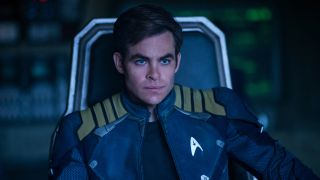
It’s been too long since Star Trek graced the big screen. The last time Trekkies watched the USS Enterprise go into warp speed in theaters was back in 2016 with Star Trek Beyond . Since then, Paramount has been trying to bring back Chris Pine ’s Captain Kirk and his crew for one last hurrah, but setback after setback has been rumored to bring down the project. However, the latest news about Star Trek 4 brings some revived hope for another galactic adventure.
Paramount Pictures and Bad Robot Productions have reportedly found a new screenwriter for Star Trek 4 in The Flight Attendant creator Steve Yockey. Per the news that comes from Variety , Yockey will pen the script for what’s expected to be the final installment of the saga starring Chris Pine, Zachary Quinto , Zoe Saldaña, Karl Urban , John Cho and Simon Pegg . It’s a huge step forward for the long-gestating project, but it should be noted that this report signals Star Trek 4 is still in early development over at Paramount.
Steve Yockey started his career in Hollywood as a writer for television shows like Awkward , Scream and Supernatural before developing HBO’s The Flight Attendant from the novel of the same name. The series starring Kaley Cuoco was cancelled after two seasons, but was critically-acclaimed throughout its run and earned Cuoco numerous accolades, alongside other aspects of the production.
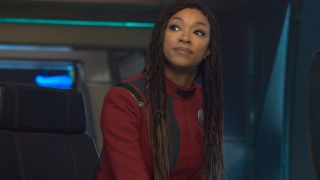
Upcoming Star Trek TV Shows: What's Ahead For The Sci-Fi Franchise
Yockey has another series coming soon to the 2024 TV schedule with Netflix’s Dead Boy Detectives . The supernatural detective comedy is based on the DC Comics property by Neil Gaiman and Matt Wagner, and is set to premiere for those with a Netflix subscription on April 25.
Over the years, there’s been numerous writers and directors attached to the next Star Trek movie, from Madame Web ’s S.J. Clarkson previously in talks to direct back in 2018, to Fargo ’s Noah Hawley being attached to write and direct back in 2019. WandaVision ’s Matt Shakman was last involved for a year before he decided to leave the project to direct the upcoming Fantastic Four movie . According to Shakman, while he very much enjoyed his time working on Star Trek 4 alongside J.J. Abrams, returning to Marvel Studios to revive the comic book crew, was “too hard to pass up.”
This step forward for Star Trek 4 comes just a few months after rumors came out that Paramount was thinking of rebooting the franchise again . A couple of months ago, it was also reported that Andor ’s Toby Haynes will direct another Star Trek movie based on a script by Abraham Lincoln: Vampire Hunter ’s Seth Grahame-Smith .
While we know very little about the direction of Star Trek 4 , here’s hoping the main cast led by Chris Pine will in fact come back once more! Check out our ranking of all the Star Trek movies as we imagine what could be in store for the iconic Starfleet crew!

CINEMABLEND NEWSLETTER
Your Daily Blend of Entertainment News
Sarah El-Mahmoud has been with CinemaBlend since 2018 after graduating from Cal State Fullerton with a degree in Journalism. In college, she was the Managing Editor of the award-winning college paper, The Daily Titan, where she specialized in writing/editing long-form features, profiles and arts & entertainment coverage, including her first run-in with movie reporting, with a phone interview with Guillermo del Toro for Best Picture winner, The Shape of Water. Now she's into covering YA television and movies, and plenty of horror. Word webslinger. All her writing should be read in Sarah Connor’s Terminator 2 voice over.
Brats: 5 Things I Had Wrong About The Brat Pack
Georgie And Mandy’s First Marriage Star Emily Osment Shares How She Feels About Moving To A Live Audience Format For The Young Sheldon Spinoff
The Fantastic Four’s Joseph Quinn Talks About Building The Dynamic Between His Human Torch And Ebon Moss-Bachrach Thing, And I Can’t Wait To See These Two Together
Most Popular
- 2 'Eat My Butt Bridgerton:' While The Boys Is Still Dominating On Amazon Prime, There's A New Show On The Streamer Its Creator Wants You To Watch
- 3 Courteney Cox Dropped A Chaotic Scream-Inspired Pride Month Tribute, And Fans Are Here For It: 'Gale Is For The Girls And The Gays'
- 4 NCIS: Tony And Ziva: What We Know So Far About The Streaming Spinoff
- 5 The Kardashians Are Still Going Strong, But Hulu Just Axed Another Show I Honestly Thought Was Really Popular

The Making of Star Trek
Published in 1968, while the Original Series was still in production, the book holds the distinction of being the very first officially licensed reference book of its kind on the subject of Star Trek , as well as adding a third element to the infant Star Trek print franchise after the first official novel and comic book publications the previous year.
- 1.1 Contents
- 2.1 US print history
Summary [ ]
Contents [ ].
- Introduction, p.11
- Chapter 1. As It Was in the Beginning, p. 21
- Chapter 2. Creation, p. 31
- Chapter 3. A Spark of Life, p. 40
- Chapter 4. " The Cage ", p. 47
- Chapter 5. Inside a Television Studio, p. 66
- Chapter 6. A Blueprint for Starflight, p. 74
- Chapter 7. Voyage One , p. 100
- Chapter 8. The Second Time Around, p. 123
- Photo inset, 32 pages, unnumbered
- Chapter 1. Prelude, p. 163
- Chapter 2. The USS Enterprise , p. 171
- Chapter 3. Mission and Men, p. 202
- Chapter 4. The Ship's Captain , p. 214
- Chapter 5. Mr. Spock , p. 223
- Chapter 6. Chief Medical Officer , p. 239
- Chapter 7. Engineering Officer Scott , p. 244
- Chapter 8. Other Star Trek Regulars, p. 247
- Chapter 9. The Bad Guys, p. 256
- Chapter 1. Putting the Show on the Road, p. 261
- Chapter 2. These Are the Voyages, p. 286
- Chapter 3. Steady As She Goes, p. 301
- Chapter 1. In the Beginning Was the Word, p. 323
- Chapter 2. Making the Scene, p. 333
- Chapter 3. Feinbergers , Tribbles and Other Things, p. 342
- Chapter 4. Hunting for Aliens , p. 347
- Chapter 5. Metamorphosis: Humans and Humanoids , p. 351
- Chapter 6. Aliens – Dressed and Undressed, p. 355
- Chapter 7. Quiet in the Set, Please!, p. 362
- Chapter 8. Beyond Human Ken, p. 369
- Chapter 1. Seasons Follows , p. 379
- Chapter 2. Bits an Pieces, p. 393
- Chapter 3. Whither Star Trek?, p. 400
- About the Authors, p. 403
- Star Trek Shows, p. 404 (Episode listing for seasons 1-2)
Background information [ ]
- For his research, author Stephen Edward Poe was given full access to the stages and offices of Desilu Productions , as part of the deal he brokered between model kit manufacturer Aluminum Model Toys (AMT) and the studio. Poe, who wrote the book using his stepfather's name of "Whitfield" (although virtually all his other writing was done under his own name), shared a co-author credit with Star Trek creator Gene Roddenberry . Poe wrote the book alone, but made a deal with Roddenberry, in which they agreed that Roddenberry would proofread the book and make his corrections and notifications before it went to print. For this, he would receive co-author credit and half the royalties. It also was thought that the appearance of Roddenberry's name on the book might make it sell better. Ultimately, Roddenberry was not able to review the book due to harsh production deadlines, but received the co-author credit, as well as half of the royalties, anyway. ( Inside Star Trek: The Real Story , p. 402) The book does incorporate commentary by Roddenberry; in some editions this is rendered in all capital letters.
- The illustrations and photographs in the book were provided by Howard McClay and Frank Wright of the Desilu/Paramount Publicity Department (Poe embarked on his book in the midst of the Desilu takeover by Paramount owner Gulf+Western ), as well as by the Westheimer Company . (p. 15)
- Bonnie Trust transcribed Poe's copy, notes and interviews, and her work was described by an appreciative Poe as "herculean." (p. 15)
- Though his builds were prominently featured in the book, Wah Chang was the one major production staffer Poe could not mention by name in his book, as the former had no formal Prop Makers Union permission to work on the show.
- Poe began gathering his information shortly before or after the start of production on the second season and wrote his copy when that season went into hiatus. His writing was centered around the contents of the third-draft The Star Trek Guide , the later in-lore-famed "Writer's Bible", Roddenberry had disseminated on 17 April 1967 to his production staff during the pre-production stage of the second season. As a consequence, only cursory information on the series' third season is incorporated in the book, limited to what little preliminary pre-production information became available to Poe while he was finishing up on his copy.
- Exemplary of the last minute information was his inclusion of design sketches by Matt Jefferies for the Klingon D7-class battle cruiser , which was only introduced in the third season and had yet to premier onscreen when the book was published. Ironically, by not mentioning the AMT connection for this design, Poe (whose primary responsibility was to develop a Star Trek model kit line for his employer in conjunction with Jefferies) started a three-decades-long misconception that the D7 was a studio initiative, which it was not. As it turned out, Jefferies had designed the ship exclusively for AMT – who eagerly wanted to do a follow-up for their hugely successful 1966 USS Enterprise model kit (no. S921) – in his own spare time, and definitely not for the studio, which had not commissioned it, despite assertions and assumptions by numerous reference authors, fans , and the franchise itself to the contrary afterwards. Nevertheless, under their exclusivity agreement, the strapped-for-cash studio immediately appropriated one of AMT's two tooling masters for filming purposes. It was only in 2002 that Jefferies finally set the record straight. ( Star Trek: The Magazine Volume 2, Issue 9 , p. 66)
- Something similar applied to Jefferies' orthographic views of the Enterprise which provided detailed ship dimensions on page 178. It too was not produced for the production, but rather for AMT to become featured on the box side of the 1968 second edition of their highly successful Enterprise model kit (no. S951 & beyond, and concurrently released with the above-mentioned Klingon D7 model kit). Never featured on any of the Star Trek shows, it actually conflicted with Jefferies' far less detailed plan views on pages 184-185 that were used on the show and where the ship was inferred to be slightly smaller. Nonetheless, from the moment the graphic was published fans, authors, and production staffers alike, have embraced the never on screen referenced AMT specifications as those for the in-universe vessel ever since, their non- canon status notwithstanding. See " Constitution -class: Size " for further details on the size issue.
- This work has been an influential one. Not only was it the very first detailed and specialized book title on the production aspects of Star Trek (including detailed photographs of props and set designs), it was also the very first one for a television show in general, or for that matter one of the very first for the motion picture industry as a whole. Prior to its release, publications about "behind-the-scenes" aspects of motion picture productions were either restricted to article-length magazine publications, most notably in American Cinematographer (which included the very first one on Star Trek in its October 1967 issue, the only published behind-the-scenes information to precede the publication of The Making of Star Trek ), or referenced in (single point of view) memoirs or biographies of actors and/or directors. This book set the template for all "making of..." reference books on the subject matter that have followed suit. Although the information included was limited, and by publication timing omitted the third season, the book contains the first officially published Star Trek episode listing/guide.
- The book was highly successful, already needing a reprint in November of the same year it was first published, September 1968, followed by a third printing in January 1969, having by that time sold over a million copies, according to Susan Sackett . ( Return to Tomorrow - The Filming of Star Trek: The Motion Picture , p. 417) A popular book, it has since then seen numerous reprint runs, first under the Ballantine Books imprint and subsequently under that of Del Rey , for two decades seeing at least one reprint each consecutive year. Production has seemed to have run its course though, as no 21st century editions are known after having been reprinted for over a quarter of a century. It has become, to date, the most reprinted Star Trek book ever – reference or otherwise – and thus the most successful, despite it only covering the first two seasons and never being updated to include the third.
- The 1991 stand-alone Titan Books publication was intended specifically for the UK market only, on the occasion of Star Trek 's 25th anniversary . Despite its immense popularity, and unlike later reference books, it has not seen any internationally translated versions. The 1991 Titan release has remained to date the first and only known edition published outside the USA.
- In their book The Making of Star Trek: Deep Space Nine [ page number? • edit ] , Judith and Garfield Reeves-Stevens gave this publication high praise, commenting, " It is a true classic of its kind. Not just as a chronicle of the beginning of what was to become an unprecedented, billion-dollar entertainment franchise, and not just as a behind-the-scenes trove of trivia for die-hard Star Trek fans, but as a fascinating account of the creative reality of weekly television series production in the 1960s. "
- Although it was followed in 1973 by The Trouble with Tribbles , which detailed the making of the episode of the same name, for many years this was the sole book title on the production of a Star Trek series as a whole, and thirty years later, Poe followed up on his work with the similarly conceived 1998 title A Vision of the Future - Star Trek: Voyager . The book also inspired the reference book The Making of Star Trek: Deep Space Nine . There were also books produced chronicling the making of the first few Trek films.
- The Star Trek: Deep Space Nine production staff used The Making of Star Trek when working on " Trials and Tribble-ations ". ( The Magic of Tribbles: The Making of Trials and Tribble-ations [ page number? • edit ] )
US print history [ ]
- 1st printing, October 1968 (Canadian)
- 2nd printing, December 1968 (cover price $0.95)
- 3rd printing, January 1969 (cover price $0.95)
- 4th printing, April 1969 (cover price $0.95)
- 5th printing, July 1970 (cover price $0.95)
- 6th printing, November 1970 (cover price $0.95)
- 7th printing, June 1971 (cover price $1.25)
- 8th printing, February 1972 (cover price $1.25)
- 9th printing, August 1972 (cover price $1.50)
- 10th printing, May 1973 (cover price $1.50)
- 11th printing, January 1974 (cover price $1.50)
- 12th printing, May 1974 (cover price $1.50)
- 16th printing, 12 March 1975 , (cover price $1.95)
- 17th printing 1975 , (cover price $1.95)
- 18th printing 1976 (cover price $1.95)
- 19th printing, January 1977 , (cover price $2.25)
- 20th printing 1978
- 21st printing 1979
- 22nd printing, 12 August 1986 , (cover price $5.99)
- 27th printing, September 1991 ( 25th anniversary -edition), (cover price $5.99)
- 33rd printing 1994
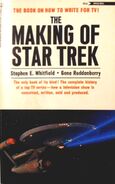
- 1 Daniels (Crewman)
- 3 World War III
- The Original Series
- The Animated Series
- The Next Generation
- Deep Space Nine
- Strange New Worlds
- Lower Decks
- Star Trek Movies
- TrekCore on Twitter
- TrekCore on Facebook

The now-tossed Star Trek 4 went through many iterations since the first announcement in July 2016 , including a story by legendary Hollywood director Quentin Tarantino, a surprise 2022 Kelvin cast announcement that apparently Chris Pine and company only learned about through the press, and prequel story set “decades before the 2009 film.”
Following the new Star Trek 5 announcement, star Chris Pine reportedly reacted “with a deep sigh” according to Deadline . “Chris is excited learn about this new film through today’s studio announcement,” said a representative for the actor, “because it went really well the last time this happened, right?”
Also expected for the Trek 5 reunion are co-stars Zachary Quinto (Spock), Zoe Saldana (Uhura), Simon Pegg (Scotty), Karl Urban (“Bones” McCoy), and John Cho (Sulu). Actor Anton Yelchin, who portrayed Chekov in the first three films, passed away in 2016.
While little is known about the planned story of this new film, sources close to Trek 5 development hear that Paramount is pursuing Dune and Wonka star Timothée Chalamet for the role of “Sybok,” half-brother of Spock, originated by actor Laurence Luckinbill in 1989.
- Behind The Scenes
- paramount pictures
- Star Trek 5
Related Stories
Factory entertainment announces two new exclusive star trek collectibles, including “catspaw” enterprise prop replica, weeklytrek podcast #251 — the season 2 star trek: prodigy trailer is here, see new images from star trek: prodigy season 2, search news archives, new & upcoming releases, featured stories, lost-for-decades original star trek uss enterprise model returned to roddenberry family, star trek: lower decks cancelled; strange new worlds renewed for season 4, our star trek: discovery season 5 spoiler-free review.
TrekCore.com is not endorsed, sponsored or affiliated with Paramount, CBS Studios, or the Star Trek franchise. All Star Trek images, trademarks and logos are owned by CBS Studios Inc. and/or Paramount. All original TrekCore.com content and the WeeklyTrek podcast (c) 2024 Trapezoid Media, LLC. · Terms & Conditions

Giant Freakin Robot
Star Trek IV Backstory Erased Because Of A Child
Posted: June 28, 2024 | Last updated: June 29, 2024
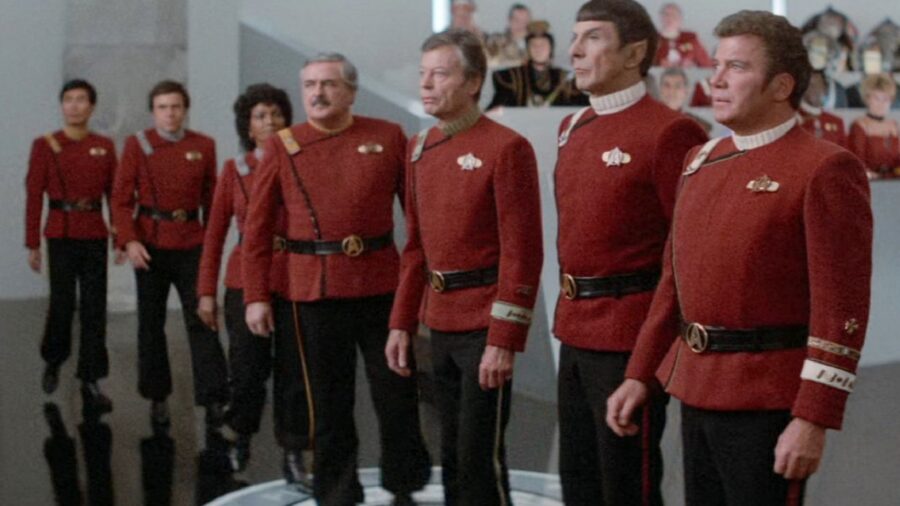
Ask someone to name a Star Trek movie, and even the most casual fan will say, “The one with the whales.” Star Trek IV: The Voyage Home manages to charm even the most hardcore haters with its fish-out-of-water time travel story and light-hearted tone. Unfortunately, one charming scene in Star Trek IV had to be scrapped thanks to a shy child actor.
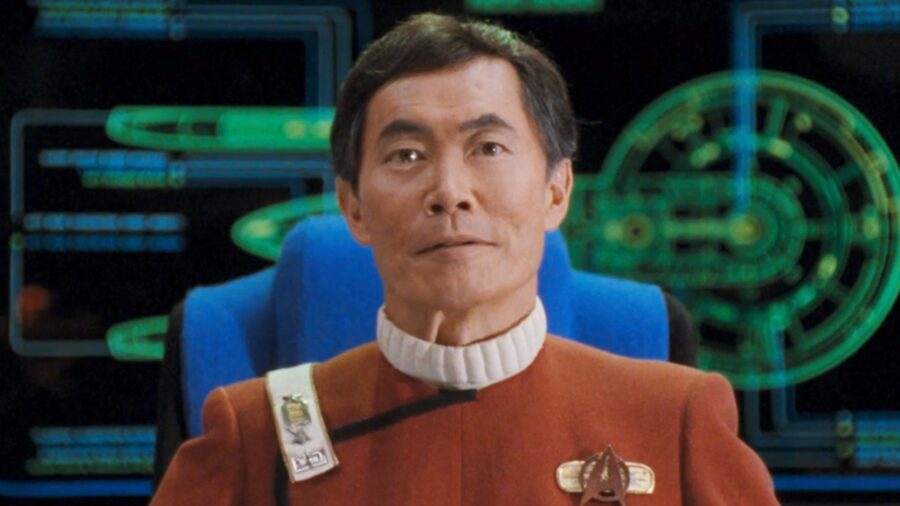
The scene in question would have given more backstory to the Enterprise’s famous helmsman, Hikaru Sulu. According to the original Star Trek IV shooting script, Sulu was supposed to run into a child on the streets of 1980s San Francisco who turned out to be one of his ancestors.
The scene, as planned, would have given Sulu a touching moment, something the character doesn’t really get in the movie as it exists now.
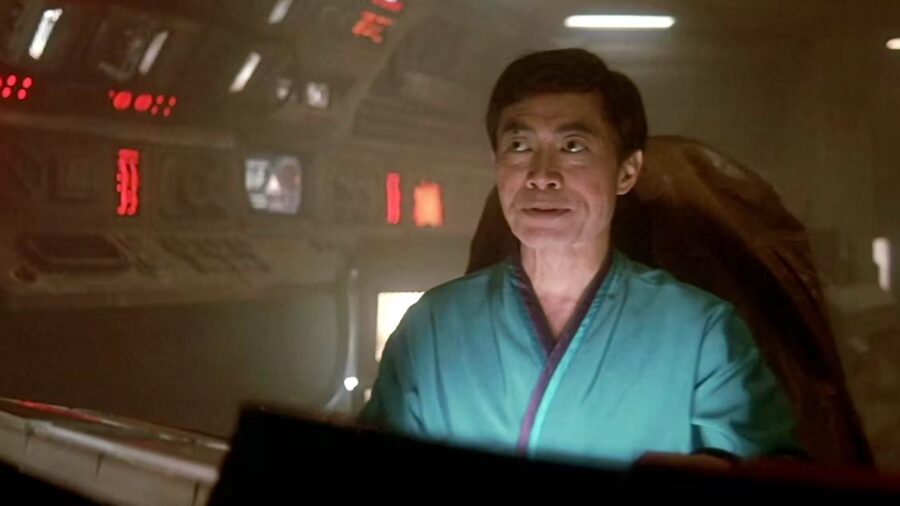
Sulu Meets Sulu
According to the Star Trek IV screenplay, a young Japanese child passes Sulu on the sidewalk, causing the helmsman to do a double take. The boy then asks Sulu in Japanese if he is his uncle Akira. Sulu then addresses the boy in his native Japanese tongue to tell him he must be mistaken.
The boy starts to continue walking, but Sulu stops him to ask his name. When the boy replies that his name is Hikaru Sulu, the other Sulu is “visibly moved” and tells the child that he will have a long, happy life. Something Sulu is in a unique position to say to the boy since he hails from the 23rd century and knows his family history.
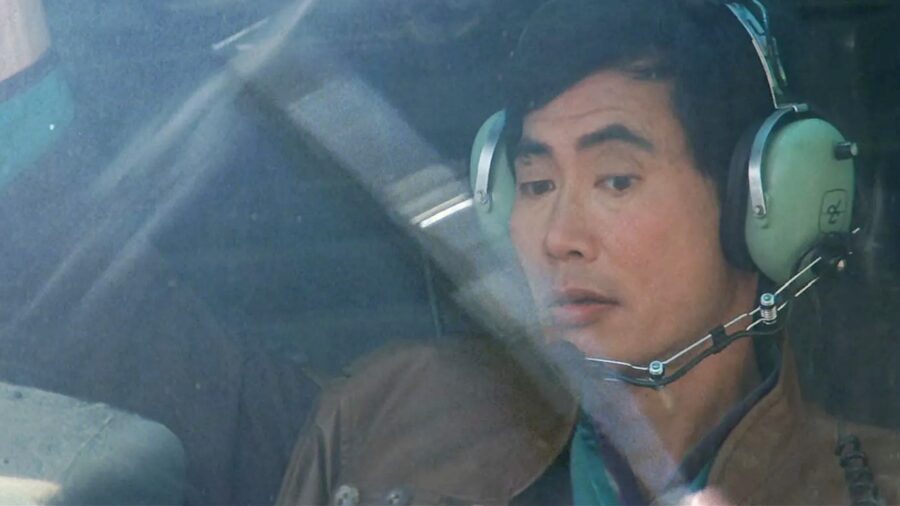
No Hate For The Kid
What happens next would have cemented the scene as one of Star Trek IV’s most touching, as Sulu tells a curious Bones the child was a distant relative. “That, Doctor, was my great-great-grandfather,” Sulu says in the script. So what went wrong?
According to Star Trek IV actors George Takei and William Shatner, in their respective memoirs, the child simply would not perform when it was his time.
Both men blamed the child’s skill level—he was not a professional actor—and an overbearing mother on set for making the boy nervous. Neither seemed to have any animosity towards the child and remembered the day fondly.
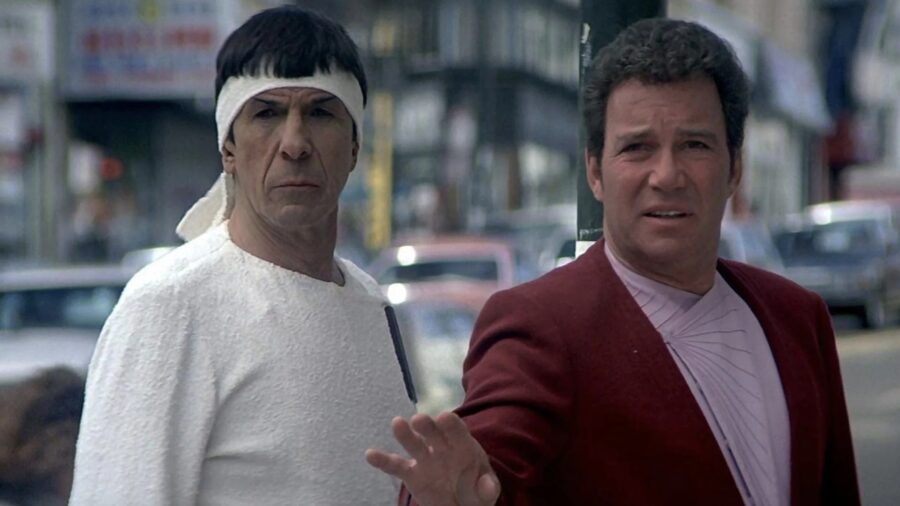
They Did Their Best
George Takei has said that both he and director Leonard Nimoy played with the child and attempted to loosen him up. Pictures even exist that show the two men smiling while the boy looks down at the ground, clearly too shy to perform. By all accounts, the two men spent hours on the Star Trek IV set trying to get the child used to being on a film set.
Sadly, the scene was being shot on location in San Francisco, meaning that the production was at the mercy of the waning sunlight. Eventually, Nimoy, like all good directors, had to make the best decision for the movie. Unfortunately, that decision was to cut the scene from the film entirely.
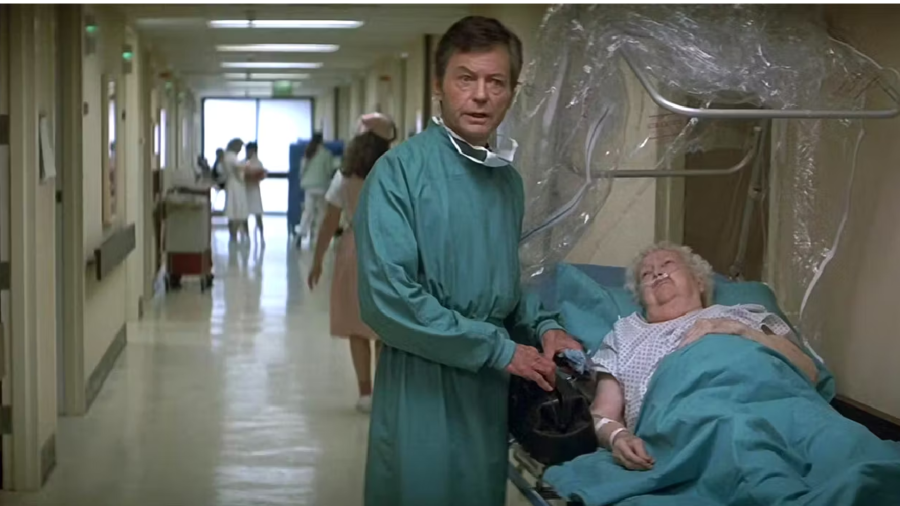
The Novelization
Unlike most deleted scenes, the Star Trek IV scene with the child was never actually shot. As a result, fans can’t determine for themselves whether the scene would have worked. There’s a very good possibility that even if things went exactly as planned, the scene would still have been axed for slowing down the pace and not contributing to the story.
Luckily, the scene still exists in the Star Trek IV novelization and the comic book adaptation, so fans can still experience it in some form or another.
More for You
LeBron James and Lakers lose desired NBA star to New Orleans Pelicans
Boeing unveils 'Revolver' hypersonic missile launcher
So THAT'S Why Singers Lose Their Accent When They Sing
14 fascinating things most Americans don’t even know about the USA
How Big Is the Average Social Security Check of a Lower-Class Retiree?
'It's a money pit': Peter Schiff says a house 'depletes your savings' and costs you a 'crazy' amount of money, believes that renting is a ‘better option’ for many Americans. Do you agree?
I study people with high emotional intelligence for a living—8 things they never ever do when talking to others
Putin lunges for 'banned' missiles
Watch Rihanna Serenade A$AP Rocky with This Singles' Anthem
The 8 Most Beautiful Places to Live In New Jersey That Are Still Affordable
"He’s just an average player" — Dennis Rodman believes LeBron James wouldn't thrive in the late 80s or early 90s
‘They took almost everything’: Cincinnati veteran, 80, is living in his car after selling his home to a company that offered sale leasebacks. Here’s what you can learn from his situation
Map reveals best places to live in the US if nuclear war breaks out
How Many Fighter Jets Does Ukraine Have: What Kind Are They?
Greg Olsen thinks NFC favorite is clear
Fewer Young Men Are Going to College — Here's a State-By-State Breakdown of Where They'll Have the Best and Worst Job Prospects
You have 4 days to get paid up to $349 as part of an Apple iPhone settlement — here's how to know if you qualify
Baking Soda Makes a Great DIY Weed Killer—Here's How to Use It
'We're living proof': Americans are being paid cash by governments to move to rural areas — is inflation relocation a cure to the cost-of-living crisis?
The Ho-Hum Box Office of Kevin Costner's ‘Horizon' Carries a Message: Don't Turn Movies Into Television
The Entire Star Trek: Discovery Timeline Explained
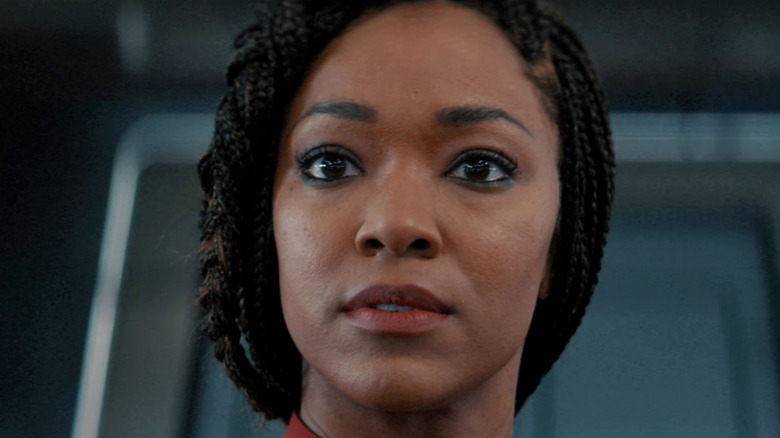
For a series ostensibly about exploring the galaxy and meeting new lifeforms in the hopes of sharing knowledge and resources, there sure is a lot of time travel in "Star Trek." It's been present from the very beginning, as even Kirk and crew visited the past multiple times . Two of those adventures resulted in the iconic episode "The City on the Edge of Forever" and "Star Trek 4: The Adventure Home."
Modern "Star Trek" adventures have embraced this aspect of the universe, as time travel was also the direct cause of the Kelvin Timeline featured in the 2009 "Star Trek" film and its sequels. When the Romulan Nero traveled back in time and destroyed the USS Kelvin, killing James Kirk's father, he accidentally contributed to the creation of a new universe running parallel to the prime timeline. Ultimately, time travel has become every bit as important to "Star Trek" as exploration.
"Star Trek: Discovery" is no exception to this. Initially a prequel series set ten years before the original series, it soon became a sequel set further into the future than any other "Star Trek" installment. Time travel tends to muddy the narrative progression of a story, so we will be looking at where "Star Trek: Discovery" started to shed some light on where it ended up. Here is the entire "Star Trek: Discovery" timeline explained.
A visit to Talos
"Star Trek: Discovery" is set ten years before what is now referred to as "Star Trek: The Original Series." However, one episode of "The Original Series" actually occurs before "Discovery." In many ways, it is the beginning of the entire "Star Trek" franchise. While most viewers back in the late '60s probably remember it as the story told in the exciting two-parter "The Menagerie," which reuses the footage captured for the original "Star Trek" pilot called "The Cage."
We have to begin here because these events play a crucial role in "Star Trek: Discovery" Season 2. "The Cage" sees the Enterprise crew, led by Captain Christopher Pike, visiting Talos IV, encountering a strange alien race. These are the Talosians, telepaths who experience life by manipulating beings they keep in their menagerie. By forcing Captain Pike to endure multiple illusions of their creations, they hope to understand love, anger, fear, excitement, and other emotions they forfeited by choosing to further develop their mental abilities.
Years later, after Captain Pike temporarily assumes command of the USS Discovery, he is forced to revisit Talos IV to cure Spock of his current mental disorder. Not only is it a chance to save Spock's life, but it also allows Pike to seek out closure regarding his past experiences on the planet.
The Battle at the Binary Stars
"Star Trek: Discovery" officially begins with a huge two-part story called "The Vulcan Hello" and "The Battle at the Binary Stars." This is where we meet the star of the show, Commander Michael Burnham, the first officer of the USS Shenzhou. While most "Star Trek" shows tend to be ensemble pieces, "Discovery" belongs to Burnham and it is her arc that we follow.
This opening episode sees Starfleet encountering Klingons for the first time in about a century. An extremist group of Klingons led by the xenophobic T'Kuvma engaged in a devastating battle with the USS Shenzhou after an altercation with Burnham resulted in the death of one of their own. This opening battle becomes a war between the Federation and the Klingons, the effects of which are still being felt during "The Original Series" and the six original "Star Trek" movies .
Following this battle, Michael Burnham is stripped of her rank and sentenced to life in prison — which leads to the true beginning of the show.
Six months later
Following Michael's sentencing, the show jumps ahead six months. While being transferred to a new prison, there's an emergency and the Discovery arrives to save her. While on the ship she meets its captain, a dark and elusive man named Gabriel Lorca, and its crew. She also reunites with her old friend from the Shenzhou, Commander Saru. Healing their relationship following her mutiny is a major part of the first two seasons of "Star Trek: Discovery."
Lorca believes that Michael's knowledge and experience could be of some use to them on the Discovery, so he invites her to unofficially join them as a specialist. The reasons behind Lorca's decision to go out of his way to save her, and why he wants her working with him on the Discovery, is another major element to the first season. His character comes off as a little strange right away, as Starfleet captains tend to be fairly approachable and diplomatic. However, Lorca is intimidating, conniving, and a little too adept at war to fit the typical captain archetype.
Taking Control
To correctly understand the timeline of "Star Trek: Discovery," we next need to dive into some events that are revealed during Season 2 but take place in Season 1.
Section 31 is the secret Black Ops division of the United Federation of Planets . They operate in the shadows, carrying out missions the Federation doesn't want to be made public. They feature heavily in "Star Trek: Discovery" and its second season. Following the events of "The Battle at the Binary Stars," Section 31 starts using a threat assessment artificial intelligence called Control in the hopes of preventing wars.
The idea is the Federation would give Control information regarding potential threats, and Control would then provide suggestions on how to proceed. As often happens in science fiction when artificial intelligence is involved, things go haywire when Control decides it no longer needs human beings to implement its suggestions. Instead, it assumes "control" of human beings to enact its agenda. This leads to the massive time jump the USS Discovery would take into the future during the end of Season 2.
Into the Mirror Universe
The USS Discovery has an experimental new system called a spore drive. It allows the Discovery to travel along a microscopic network spread throughout the universe, effectively making instant travel possible. It's an incredibly complex system, one that Forbes notes was inspired by a real-life mycologist, which can be used to break the barriers between realities.
The idea is proposed to astromycologist Commander Paul Stamets by Captain Gabriel Lorca. Stamets is considering leaving Starfleet, but Lorca convinces him to stay on to try one final experiment to see if it truly is possible to visit alternate realities. The experiment works, and the entire crew of the USS Discovery is transported into the classic evil dimension of the "Star Trek" universe — the Mirror Universe .
In the "Star Trek" Mirror Universe the heroes are villains and the villains are heroes, and it is soon revealed that this is where Lorca is from. He arrived in the prime timeline, took over the original Gabriel Lorca's life, and orchestrated events to unite with Michael Burnham — who was his lover in the mirror universe — and use the spore drive to return to his universe and overthrow Emperor Georgiou.
While the time the crew spends in the mirror universe might seem brief, it turns out that nine months pass during that time.
Nine months later
When Gabriel Lorca dies in the mirror universe, the crew of the USS Discovery returns to their native universe — but they've brought the emperor with them.
One of Michael Burnham's defining character traits is parental issues. She lost her human parents at a very young age. She was then adopted by the Vulcan Sarek and his human wife, Amanda. They raised her on Vulcan with their son Spock, effectively making her Spock's human step-sister .
Although she tried to live like a Vulcan, her human emotions were far too powerful. As a result, when she joined Starfleet and was assigned to serve on the USS Shenzhou, she gravitated to its human captain Phillipa Georgiou, seeing her as a maternal figure. Tragically, Georgiou died in the Battle of the Binary Stars, and the guilt of her loss has tortured Burnham ever since. Upon arriving in the mirror universe and finding another Georgiou, she can't help but try and bring her back to the prime timeline, hoping to correct her biggest regret.
Back in the prime timeline, they discover that nine months have passed and the war has not been going well. Discovery is boarded by Sarek and Admiral Cornwell, who informs the recently-returned crew that the Klingons have almost won the war.
The mystery of the Red Angel
By the end of Season One, the Klingon War is over, and there is an uneasy peace between the two sides. However, the crew of the Discovery doesn't have long to reflect on these events, as they soon encounter the Enterprise and are boarded by Captain Christopher Pike. Pike has been directed to temporarily assume command of the Discovery to research red burst anomalies that have been popping up all over the galaxy.
The red bursts are caused by an entity referred to as the Red Angel. The identity of this entity and the reasons for its actions are complex but intimately related to Michael. It turns out that there are two Red Angels — one is Michael Burnham's mother, Gabrielle, and the other is Michael herself. The form of the angel is actually a suit capable of traveling through time developed by Michael's parents as a project for Section 31.
At some point, Gabrielle decides to use the suit to escape an attack from Klingons but winds up in the distant future. She sees that the AI system Control has taken over the galaxy, so she uses her suit to jump around in time in the hopes of preventing Control from evolving and spreading across the galaxy. Michael then uses the suit to send signals that appear as red bursts for the crew of the Discovery to follow, defeat Control, and travel to the future.
The all-knowing Sphere
Season 2 of "Star Trek: Discovery" is full of big, wild ideas that could serve as the basis for a film or an entire series. The first, of course, is the threat of Control. The second is the Red Angel. The third is a sentient, planet-sized lifeform called the Sphere.
This Sphere has spent hundreds of thousands of years exploring the galaxy, collecting information and experiences. It has existed for such a long time that it is now dying. With such a wealth of knowledge and experience, it doesn't want to be forgotten, so it transfers its memory to the Discovery's computers.
As wonderful a find as this is, it is also incredibly dangerous. When Airiam, a cybernetic member of the Discovery crew, is infected by a future version of Control, she is directed to transfer all the sphere data on artificial intelligence to the current form of Control. With that information, Control will be able to gain full sentience and take over the galaxy — just as seen in Spock's vision from the Red Angel.
Defeating Control
For any "Star Trek" fans upset that "Star Trek: Discovery" takes place 10 years before "The Original Series" but the technology is significantly more advanced — or that Spock never mentioned having a human step-sister — their fears were partially quelled when the ship made the jump ahead almost one thousand years.
By the end of Season 2, Control was defeated, the mystery of the Red Angel was solved, and the need to get the sphere data to a safer time period arose. With the data merging to Discovery's computers, the decision was made not to try and delete the data but take it into the future. Using the Red Angel suit, Michael Burnham drags the USS Discovery into a time in a future not yet explored by the "Star Trek" franchise .
Once Discovery is gone, the Federation decides to clear the ship's existence from all Starfleet records and never speak of it, the crew, or its mission again. Thus, Michael Burnham is never mentioned, nor is the Discovery or its experimental spore drive.
The future of Starfleet and the Federation
The jump to the future is successful, but Michael arrives there alone. Since she was towing the ship, not riding in it, the trip was different for her. Immediately upon arriving, she rams into a ship piloted by Cleveland Booker before being pulled in by a nearby planet's gravity, regaining control of the Red Angel suit only seconds before splattering on its surface.
At first, she is panicked that Discovery won't answer her call but is soon thrilled by the knowledge that there is life on this planet. She eventually meets Cleveland Booker and discovers that the Federation barely exists anymore. The reason for its diminished size and influence was something called the Burn. In the 31st century, nearly every warp core installed in Federation ships exploded, wiping out swaths of life and nearly destroying the Federation. Exactly what caused this "burn" is the central mystery of Season 3.
One year later
In this new world, where dilithium is more precious than ever, Michael travels the galaxy, trading it for goods and services. She spends an entire year recording her experiences and searching for any sign of the Discovery. Finally, her search efforts pay off, and she is reunited with her crew. In a completely new headspace, Michael isn't sure about serving on the Discovery any longer. True, she earned back her respect and rank but is she is more interested in solving the mystery of the Burn and restoring the Federation rather than limiting herself to a single ship.
By the end of Season 3, the mystery surrounding the Burn is solved, the Federation is in the early stages of reconnecting with its lost members, and Michael joins the crew of the Discovery again. This time, however, she isn't a specialist or a first officer — she is the captain.
Season 4 is still set in the 32nd century and Michael is now known as Captain Michael Burnham. Her arc mirrors the real-life arc of the show. She started as a first officer who lost everything and worked her way back to a command position, while "Star Trek: Discovery" began life as a prequel with a dubious connection to canon and became a sequel that takes the franchise to brand new heights.

IMAGES
VIDEO
COMMENTS
Star Trek IV: The Voyage Home is a 1986 American science fiction film, the fourth installment in the Star Trek film franchise based on the television series Star Trek.The second film directed by Leonard Nimoy, it completes the story arc begun in Star Trek II: The Wrath of Khan (1982), and continued in Star Trek III: The Search for Spock (1984). Intent on returning home to Earth to face trial ...
Nimoy gave the story to screenwriters Steve Meerson and Peter Krikes. They drafted a 140-page script, which went through two rewrites. But the result still wasn't very convincing. Nicholas Meyer — who had cobbled together the best parts of the various scripts for Star Trek II — was called in to once again put the story together.
A new "Star Trek" film is in the works at Paramount with "Andor's" Toby Haynes on board to direct and Seth Grahame-Smith penning the script, Variety has confirmed. While plot details are ...
Star Trek IV: The Voyage Home marks its 30th anniversary on November 26th. To celebrate, we are sharing 30 favorite facts from the production we learned while researching the film's co-writer Nicholas Meyer's library archives at the University of Iowa. Let's sling shot around the sun, pick up enough speed, and time warp back to the 1980s for a ...
STAR DATE: 1986. HOW ON EARTH CAN THEY SAVE THE FUTURE? "A catastrophe in the future can only be averted by a journey into Earth's past." - 1986 TV ad Admiral James T. Kirk is prepared to take the consequences for rescuing Spock and stealing and then losing the starship Enterprise, but a new danger has put Earth itself in jeopardy. Kirk and his crew must travel back in time in an old Klingon ...
Logo for the Star Trek reboot films. Star Trek 4 is the working title of an American science fiction film in development at Paramount Pictures based on the television series Star Trek by Gene Roddenberry.It is intended to be the 15th feature film in the Star Trek film franchise and the 5th of the franchise's reboot films.There have been several different iterations of the film in development ...
That footage also inspired a desire to learn all there was about the making of Star Trek IV: The Voyage Home.. Here are some of the favorite fun facts about the making of the film that we have learned while researching the behind-the-scenes memos, scripts, and production information available at the University of Iowa Library's "Papers of Nicholas Meyer Collection."
In April of 2018, S.J. Clarkson was hired to direct Star Trek 4. As the first female director of a Trek feature film, this was a notable milestone. Alas, her take on the USS Enterprise was not to ...
2016 marks the 50th anniversary of the Star Trek franchise - and the release of Star Trek Beyond, the 13th feature film in the series.To celebrate this big year, and ponder the deeper meanings ...
Star Trek 4 is shrouded in mystery and apparent defeat. The sequel to Star Trek: Beyond on J.J. Abram's Kelvin timeline is currently stuck in dry dock. There have been plans for Paramount to ...
While details on the story and cast are still unknown, the film has the potential to explore various aspects of the Star Trek universe, including the Kelvin timeline and the Prime universe. The release date for Star Trek 4 is set for June 9, 2023, but it is subject to change depending on the progress of production.
Steve Yockey, creator of the Max series "The Flight Attendant," is joining Starfleet as the new screenwriter for " Star Trek 4.". Story details remain under a powerful cloaking device, but ...
Quentin Tarantino's movie would have been based on the Star Trek: The Original Series episode "A Piece of the Action", in which the Enterprise crew discovers a planet with a culture based on 1920s gangsters.Rather than set the movie on a planet that had been inspired by an old history book, Tarantino's Star Trek 4 would have sent Kirk's Enterprise back to 1920s or 30s Chicago.
Article continues after ad. This version of Star Trek 4 would unite father and son, with the official synopsis as follows: "Chris Pine's Captain Kirk will cross paths with a man he never had a ...
Amazon Prime Video offers it for $4.29. If you're looking for the third film, where our heroes learn the true power of the Beastie Boys, you can stream "Star Trek Beyond" on Paramount+. You can ...
Creating this sequence created some behind-the-scene's controversy. Nimoy explains: Morrison's response had a wonderful, profound effect on my thinking about these issues. (And upon the Star Trek IV script, in which Spock tell McCoy, "There are other forms of intelligence on Earth, Doctor.
Since then, Paramount has been trying to bring back Chris Pine 's Captain Kirk and his crew for one last hurrah, but setback after setback has been rumored to bring down the project. However ...
On this day in Star Trek history, filming for Star Trek IV: The Journey Home began.The first scenes of the film were shot on February 24th, 1986 in California. Filming wrapped just three months ...
The Making of Star Trek is a behind-the-scenes description of the creation of Star Trek: The Original Series, the first Star Trek series. A multi point of view reference book, in which input from a wide range of production contributors, from studio executives to costumers, was processed, it was the first of its kind.Liberally illustrated with two extensive black and white photo sections, this ...
The "punk on bus" is the real hero of the 1986 movie "Star Trek IV: The Voyage Home.". The Muni-riding rebel gives William Shatner the middle finger — did any actor in the "Trek ...
The now-tossed Star Trek 4 went through many iterations since the first announcement in July 2016, including a story by legendary Hollywood director Quentin Tarantino, a surprise 2022 Kelvin cast announcement that apparently Chris Pine and company only learned about through the press, and prequel story set "decades before the 2009 film."
According to the Star Trek IV screenplay, a young Japanese child passes Sulu on the sidewalk, causing the helmsman to do a double take. The boy then asks Sulu in Japanese if he is his uncle Akira.
"Star Trek: Discovery" officially begins with a huge two-part story called "The Vulcan Hello" and "The Battle at the Binary Stars." This is where we meet the star of the show, Commander Michael ...
The fourth season of the American television series Star Trek: Discovery follows the crew of the starship Discovery in the 32nd century, more than 900 years after Star Trek: The Original Series, as they help rebuild the United Federation of Planets following a cataclysmic event and face a space anomaly that causes destruction across the galaxy. The season was produced by CBS Studios in ...